Key takeaways:
- Understanding audience preferences through local culture and social media engagement enhances the connection during performances.
- Adapting setlists to include local music influences and traditions fosters a shared experience and emotional resonance with the crowd.
- Engaging with local communities through collaborations and interactions creates memorable performances and strengthens bonds.
- Thoughtful marketing strategies that resonate with the local culture and events can significantly boost audience engagement and attendance.
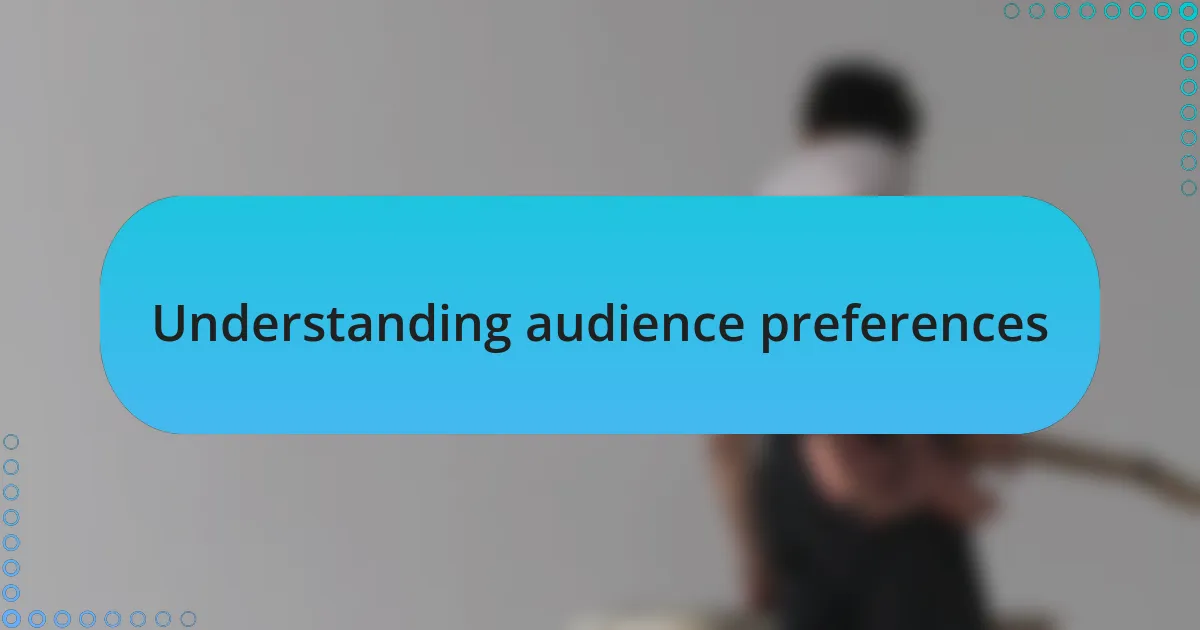
Understanding audience preferences
Understanding the audience’s preferences is crucial when planning a show in a new city. I remember the first time I played in a city known for its indie music scene; I took the time to listen to local artists and understand what resonated with the crowd. It was enlightening to discover how unique cultural influences shape musical tastes.
When I think about audience preferences, I can’t help but consider the power of social media and local music communities. Engaging with fans on platforms like Instagram or Twitter gives me real-time feedback; I often ask them about their favorite songs or genres. What better way to connect with them than to have a sense of what excites them, right?
I’ve learned that sometimes, it’s the little details that matter most. For instance, during a performance in a town known for its vibrant folk music heritage, I noticed the audience lit up when I included a traditional tune. This connection made me realize that adapting my shows isn’t just about the music; it’s about building a shared experience that speaks to their hearts.
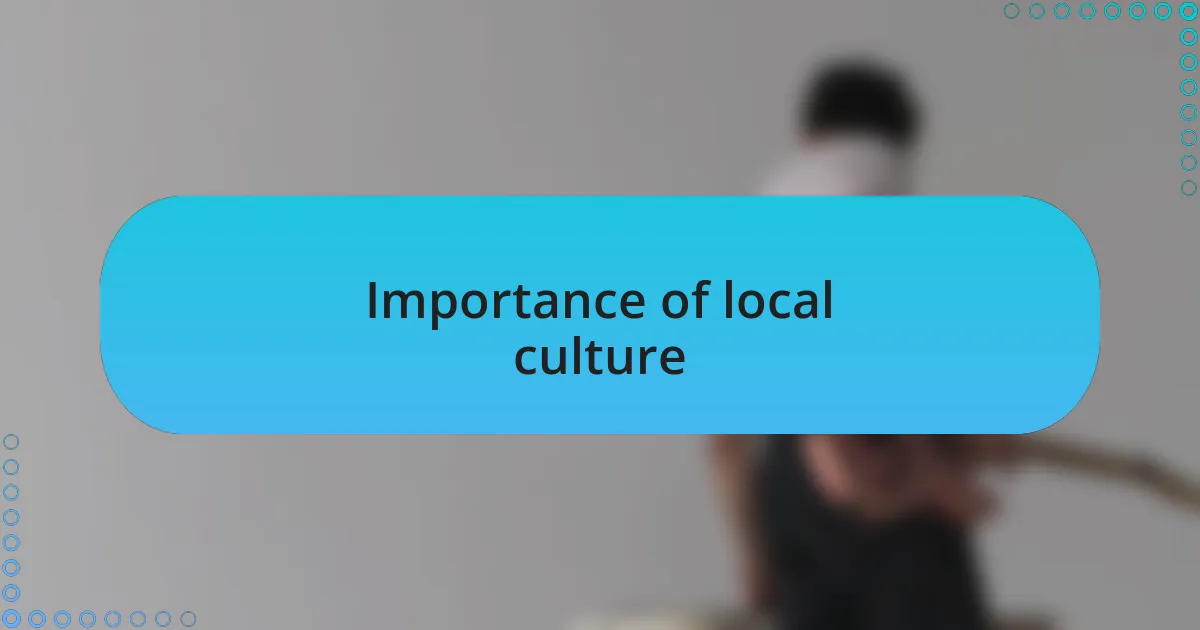
Importance of local culture
Local culture plays a vital role in shaping the atmosphere of a performance. I once performed in a city with deeply rooted jazz traditions. As I adjusted my setlist to include classic jazz standards, I could see the crowd’s energy transform. Their faces lit up, and it became evident that those familiar melodies struck a chord, weaving a connection between the music and their local heritage.
The significance of local cultural elements cannot be overstated. For example, while on tour in a city renowned for its rich history of protest music, I decided to incorporate storytelling into my songs. The audience responded passionately, reminding me how music has the power to reflect shared struggles and aspirations. How often do we overlook the nostalgia and pride tied to our hometowns? In that moment, I felt not just like a performer, but a vessel for their memories.
Understanding and embracing local culture goes beyond just music; it deepens the bond with the audience. I recall an instance where I learned a few local phrases to use between songs during a concert. The laughter and cheers I received were humbling; it demonstrated that small gestures can foster a sense of belonging. Isn’t it remarkable how these tiny connections can elevate an entire performance? They remind us that music is not just a universal language but also a reflection of the hearts and histories of the people we meet.
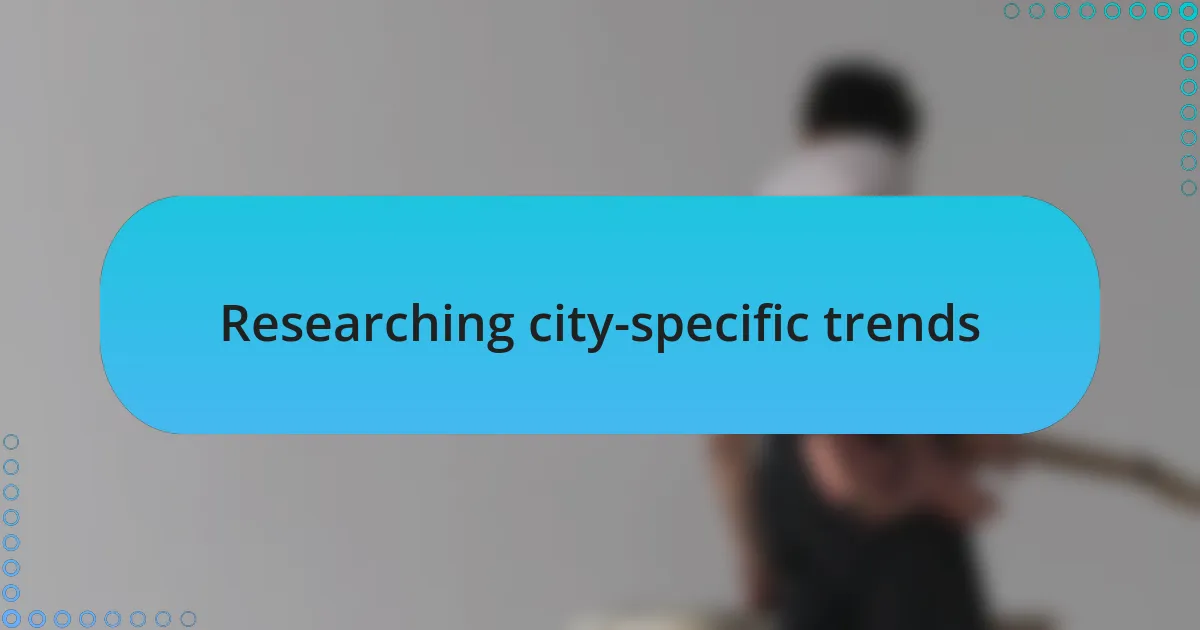
Researching city-specific trends
When I prepare for a show, I dive deep into the local music scene. I remember a gig in Nashville where I spent days exploring what was currently popular among local artists. Understanding these trends allowed me to tweak my performance, weaving in contemporary country influences that resonated with the audience. It felt like I was building a bridge from my music to theirs, facilitating a unique connection.
I also pay attention to local events and festivals that might influence the mood of my audience on a given night. For instance, after learning that my show in San Francisco coincided with a major celebration, I couldn’t resist incorporating more upbeat tracks that celebrated love and inclusivity. How rewarding it was to witness the sea of rainbow flags during my performance! That energy was electric and made me realize how crucial it is to align my show with the local vibe.
Another essential aspect is to connect with locals on social media and get their insights. I recall reaching out to fans in Chicago ahead of my performance there, asking what they wanted to hear. The responses were priceless, leading me to include a lesser-known song that resonated deeply with many. Isn’t it fascinating how a simple conversation can not only shape a setlist but also make people feel valued and heard? Engaging with the local community in this way has always enriched my shows beyond measure.
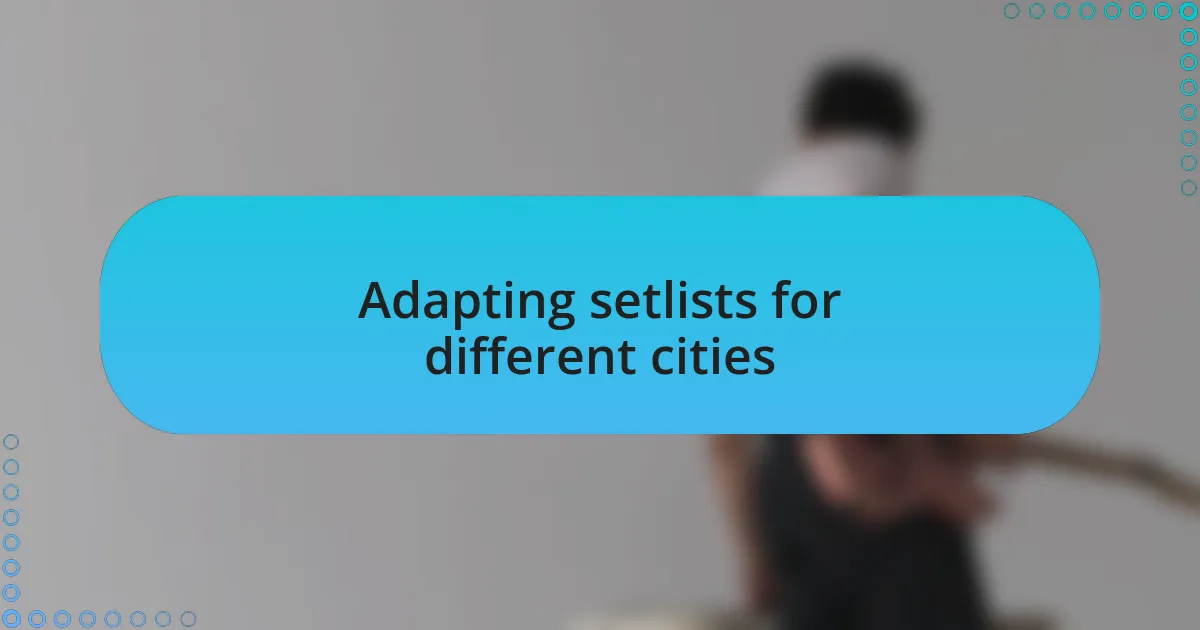
Adapting setlists for different cities
When I craft a setlist for a specific city, I often think about the memories and history attached to that place. For example, during a show in New Orleans, I incorporated traditional jazz elements into my songs. The crowd’s reaction was incredible—people swayed and sang along as if they were part of something deeply rooted. Isn’t it amazing how music can evoke such strong emotions and connections to culture?
I also gauge the diversity of the audience in different cities. In a recent concert in Los Angeles, I opted for a mix of genres, blending pop, rock, and some hip-hop influences. This choice was inspired by the city’s eclectic vibe, where I wanted everyone to feel included. Reflecting on that evening, I realized that moving through genres isn’t just about variety; it’s a way of acknowledging the rich tapestry of different backgrounds present in the room.
Another factor I consider is the energy of the venue. In an intimate space like a small club in Austin, I’ve swapped out arena anthems for softer, acoustic versions of my songs. It creates a cozy atmosphere that invites storytelling and connection. Have you ever felt that shift when a performer adapts to the space? Those moments remind me that music is a shared experience; it thrives in the uniqueness of every setting.
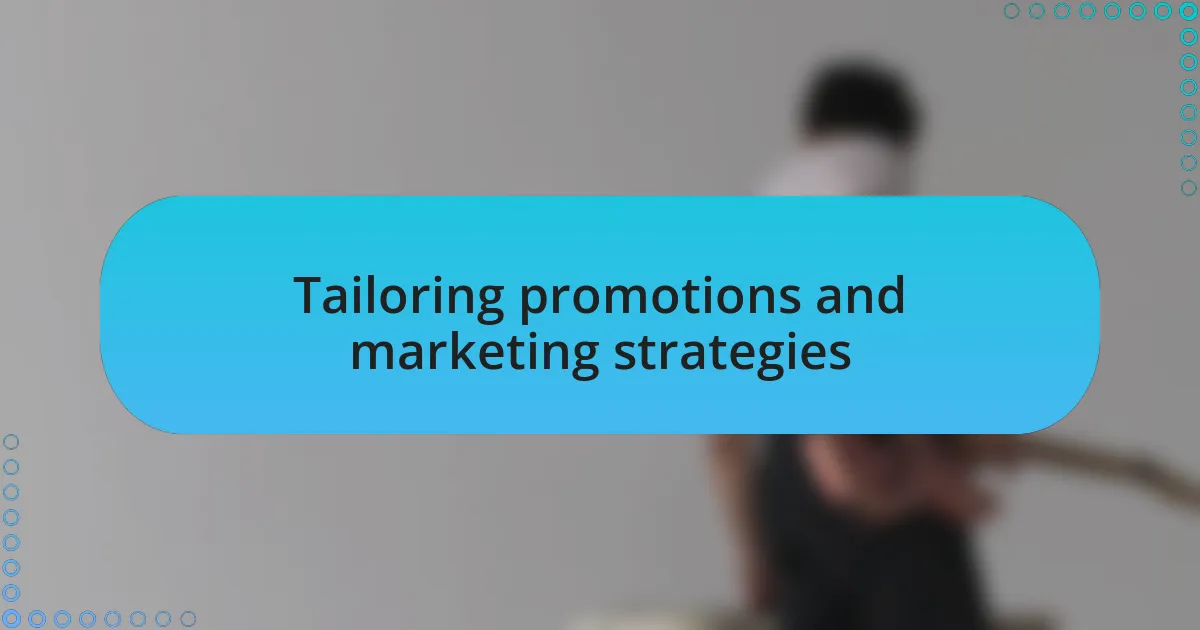
Tailoring promotions and marketing strategies
When it comes to promoting a show in a new city, I’ve learned that local engagement is key. For instance, while marketing a gig in Nashville, I collaborated with local influencers and music bloggers to spread the word. Their insights not only enhanced the promotional strategy but also made the campaign feel more authentic to the community. Isn’t it fascinating how local voices can amplify your reach?
Crafting promotional materials that resonate with the local culture is another essential aspect. One time, I designed flyers that incorporated imagery inspired by San Francisco’s iconic Golden Gate Bridge and vibrant street art. This visual connection sparked interest, and I could see how the community embraced the show as their own. Have you noticed how a well-placed local reference can instantly create a sense of belonging?
I also pay close attention to timing and local events when planning promotions. For a concert in Chicago, I scheduled the show around a popular food festival, knowing that it would draw a large crowd. The outcome was remarkable; people who came for the food ended up staying for the music! It’s moments like these that demonstrate the power of thoughtful marketing—looking beyond the stage and genuinely connecting with what matters to the audience.
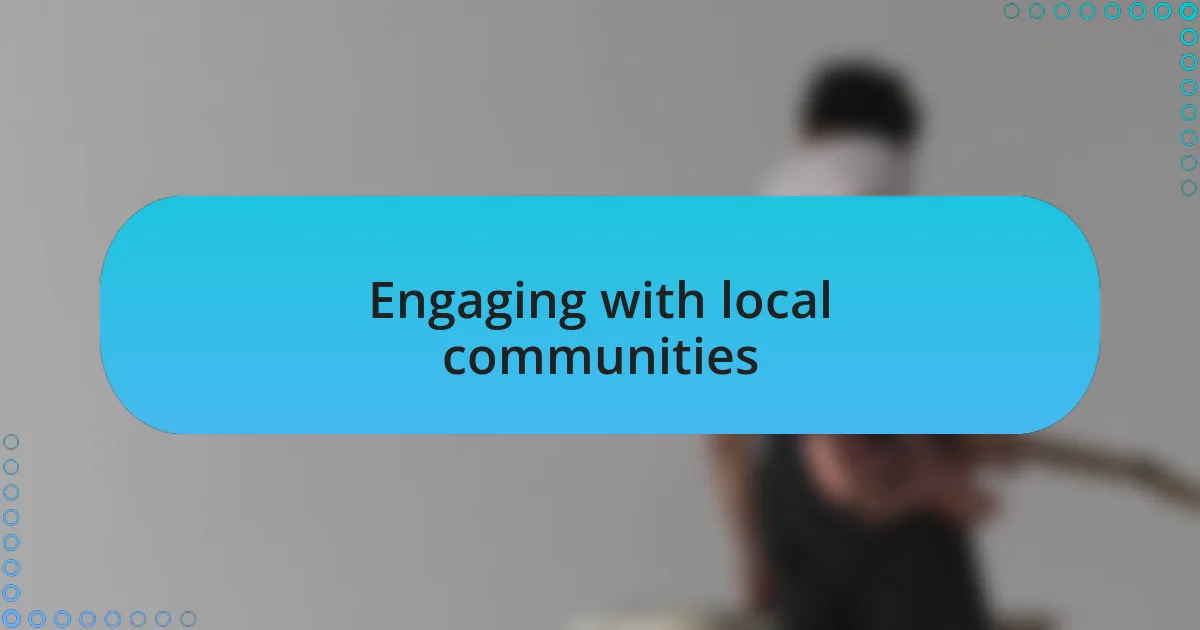
Engaging with local communities
Engaging with local communities is one of the most rewarding aspects of performing in new cities. I recall a time in Austin when I organized a post-show meet-and-greet at a local coffee shop. The intimate setting encouraged fans to share their favorite moments from the concert, and I was genuinely moved by the connections that unfolded. Isn’t it incredible how a simple conversation can transform a night into a memorable experience for everyone involved?
I often find that collaborating with local artists fosters a deeper connection with the community. During a show in New Orleans, I invited a local jazz musician to join us on stage for a few songs. The energy was electric, and it was heartwarming to see how the audience appreciated the authenticity of that collaboration. Have you ever felt that spark when local talent merges with unfamiliar acts? It creates a unique vibe that feels both personal and celebratory.
Listening to the community’s stories is crucial, too. In Philadelphia, I took the time to engage with fans both before and after the performance, encouraging them to share what music meant to them. Hearing their experiences not only enriched my understanding of the city’s culture but also made the show feel like a shared journey. Don’t you believe that these genuine interactions can leave a lasting impact, making each performance not just a concert, but a moment of collective memory?
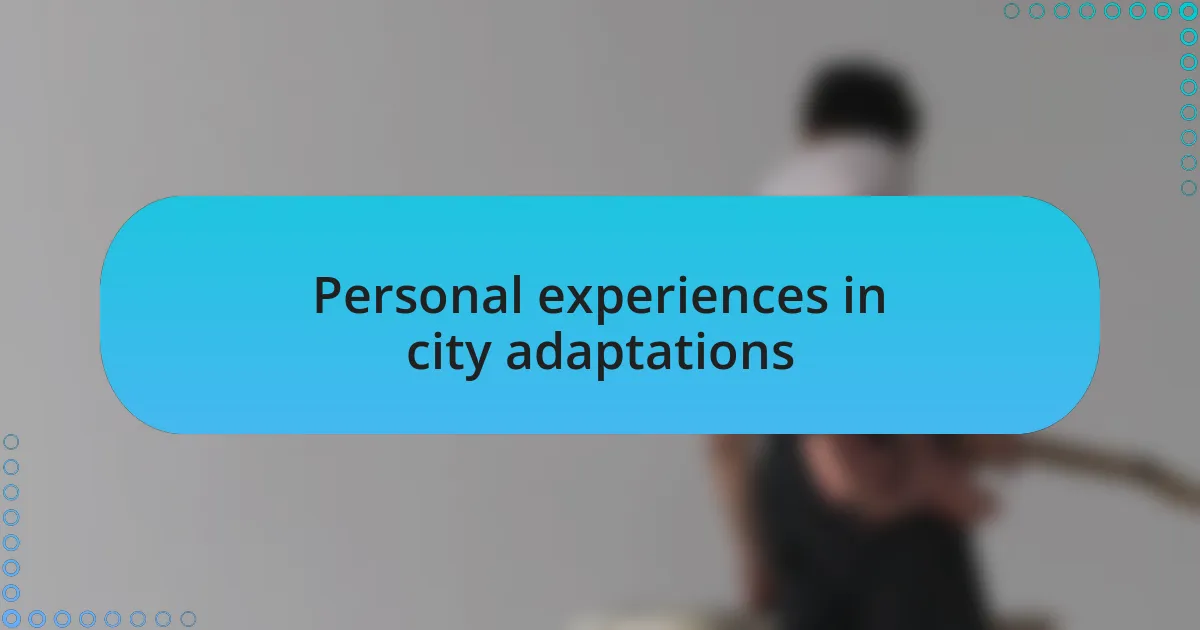
Personal experiences in city adaptations
I remember my first show in Portland; the distinct vibe of the city struck me right from the start. I noticed a crowd that was particularly engaged with indie music, and I adjusted our setlist to include some lesser-known tracks that I thought would resonate more deeply. Watching them light up during those songs felt like discovering a secret connection we all shared; wasn’t that a beautiful moment of discovery for both us and the audience?
Adapting to a city also involves embracing its quirks and character. During a performance in Seattle, I found out that the audience was obsessed with coffee culture. So, I made a playful reference to it mid-show, suggesting they might be fueled by espresso. Their laughter and nods of agreement made the atmosphere instantly warmer, demonstrating how a little humor tied to their daily life can elevate the entire experience. Have you ever had an unexpected connection like that with your audience?
My experience in Chicago taught me the power of the city’s rich history in music. I shared stories about various musical legends born from there, and the whole room lit up with nostalgia. It felt incredible to pay homage to those icons while also creating fresh memories with the crowd. Isn’t it fascinating how local pride can transform an ordinary concert into an unforgettable tribute?